Shop
- PCB Repair
- Products
- Luxury sofa
- FM Radio Kit, ICSTATION Soldering Projects Radio with LED Flashing Lights FM 87-108MHz Soldering Practice Kit DIY Radio Kit LCD1602 Display for Learning Teaching STEM Education
Description
Price: $29.99
(as of Dec 05, 2024 01:01:41 UTC – Details)
From the brand
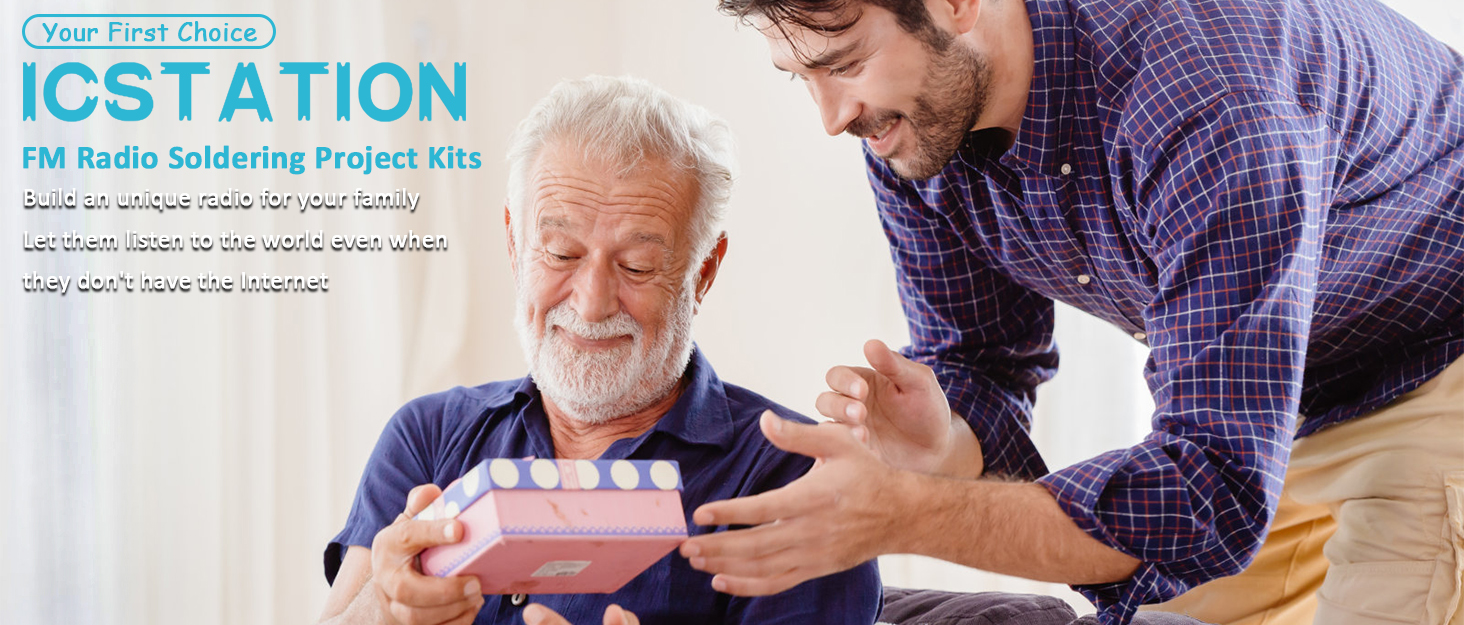

FM Radio Kit
FM Radio Kit
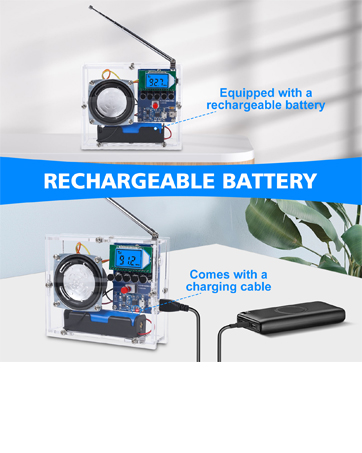

Rechargeable Battery
Search And Store ProgramsPower Off Memory FunctionWith A Headphone Jack
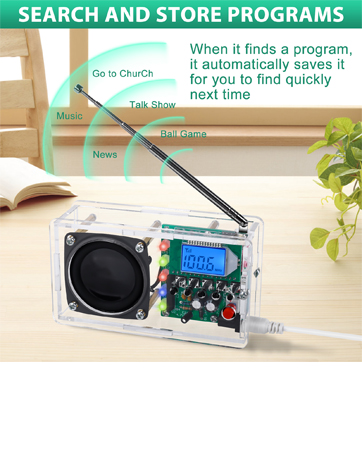

5 LED Flashing Lights
With A Headphone JackPower Off Memory FunctionSearch And Store Programs
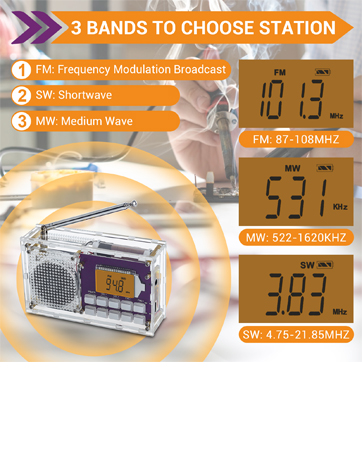

3 Bands Frequency
FM/MW/SW FrequencySearch And Store ProgramsPower Off Memory Function
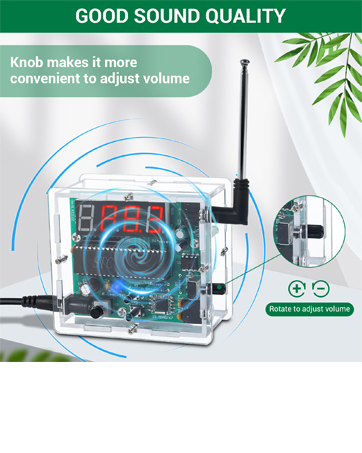

Knob volume adjustment
Cool LED LightPower Off Memory FunctionWith A Headphone
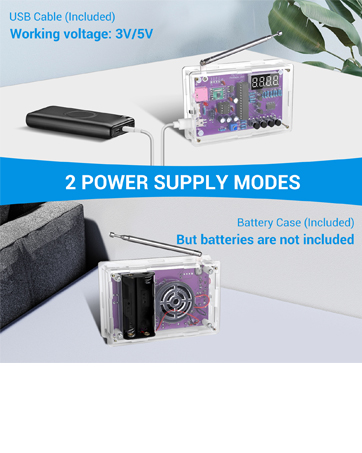

2 Power Source Modes
2 Power Supply ModesWith A Headphone Jack
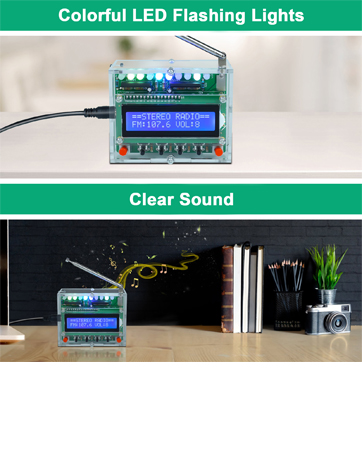

10 LED Flashing Lights
LCD DisplayCool LED Lights


ICSTATION is a well-established global online retail store with 10 years of experience.
We specialize in developing and providing a wide range of products including IC Accessories, Raspberry Pi, Robots, Arduino compatible Dev. Board, and function modules.
Thank you for considering ICSTATION as your preferred supplier.
About Business Orders
We have dedicated suppliers and professional technicians for any custom product or large quantity purchases. And we are always eager to receive inquiries from customers and hope to establish a long-term cooperative relationships.
About Our Team
We have rich technical knowledge and 10 years of experience, and are able to quickly and effectively solve various technical issues. Whatever product-related problem you encounter, we can provide professional help and support.
COOL LED LIGHT: ICSTATION DIY radio not only features the standard radio functions, but also comes equipped with 10 LED lights that add a unique twist to your listening experience. The LED lights will randomly flash different colors and pulse in sync with the beat of the music. This dynamic visual display enhances the overall ambiance and enjoyment of your radio listening experience.
LCD1602 DISPLAY: With a high-definition LCD1602 screen, ICSTATION radio allows you to adjust the frequency and volume to your liking once assembly is complete. The buttons located below the radio enable easy customization of your listening experience. Whether you prefer a certain frequency or need to adjust the volume, this radio makes it simple and intuitive. The LCD1602 screen provides clear and detailed information. Overall, this radio is a fantastic option for anyone.
PRACTICAL DIY KIT: ICSTATION soldering kit is an ideal choice for electronics enthusiasts looking to enhance their soldering skills and build a functional radio. It’s designed to provide a practical and enjoyable experience while also improving your abilities. Our team is dedicated to ensuring your satisfaction and will work with you to address any concerns or problems you may have.
GREAT PRESENTS: If you’re looking to make a personalized present for a friend or family member, a great option could be a radio DIY electronics kit. It comes with an acrylic transparent case, which not only looks beautiful but also provides protection for the delicate components inside. This means that your present will not only be visually appealing but also durable and long-lasting.
PARAMETER: FM: 87MHZ-108MHZ; Working voltage: 4.5V-5.5V DC(Support computer and power bank USB power supply); Length of the power cord: about 1m; Case size: 9.5cm*6.4cm*5.0cm
Customers say
Customers find the radio kit fun to build and has good parts. They appreciate the design. However, some customers have issues with missing parts. Opinions are mixed on the instructions, functionality, sound quality, and value for money.
AI-generated from the text of customer reviews
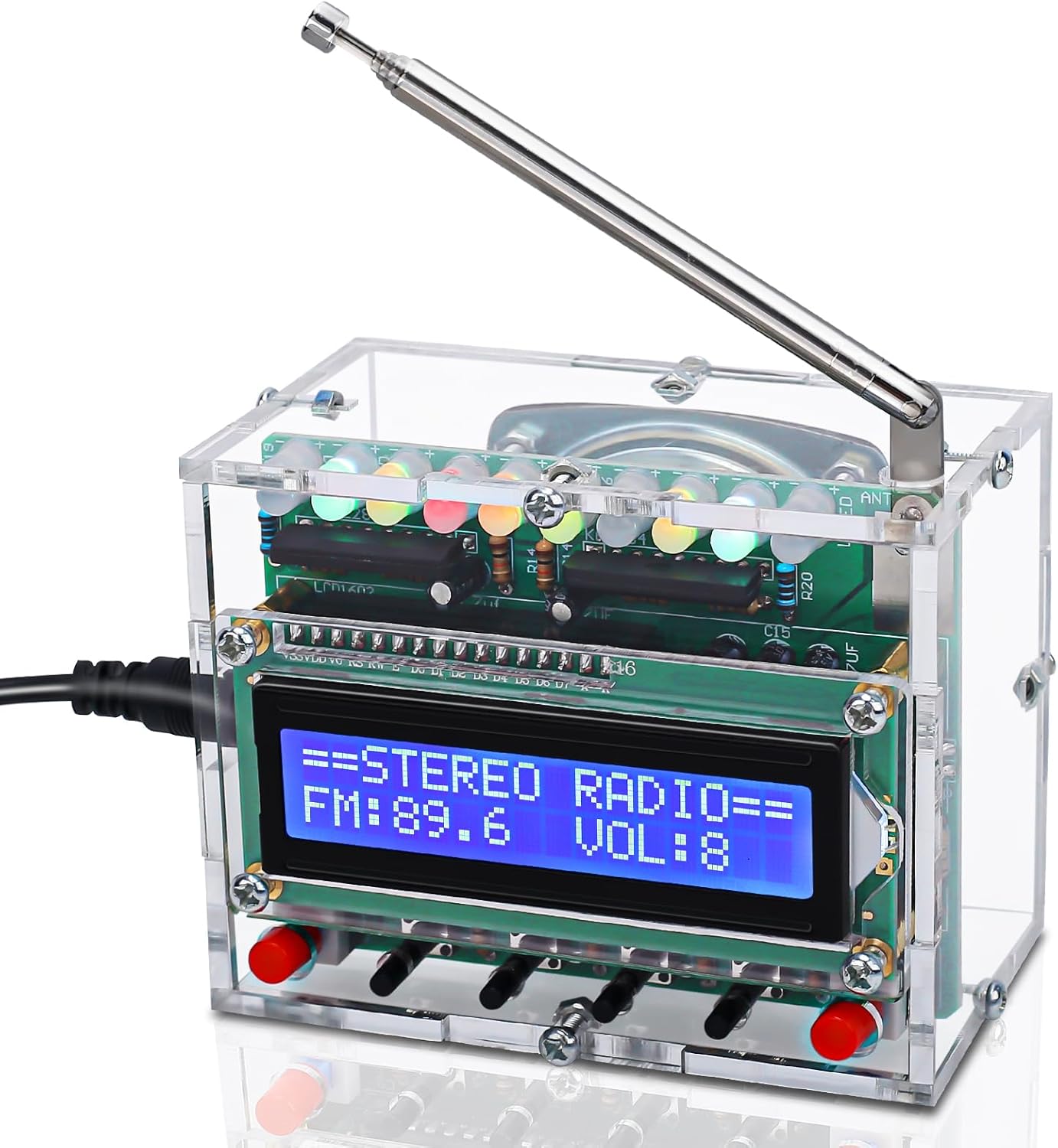
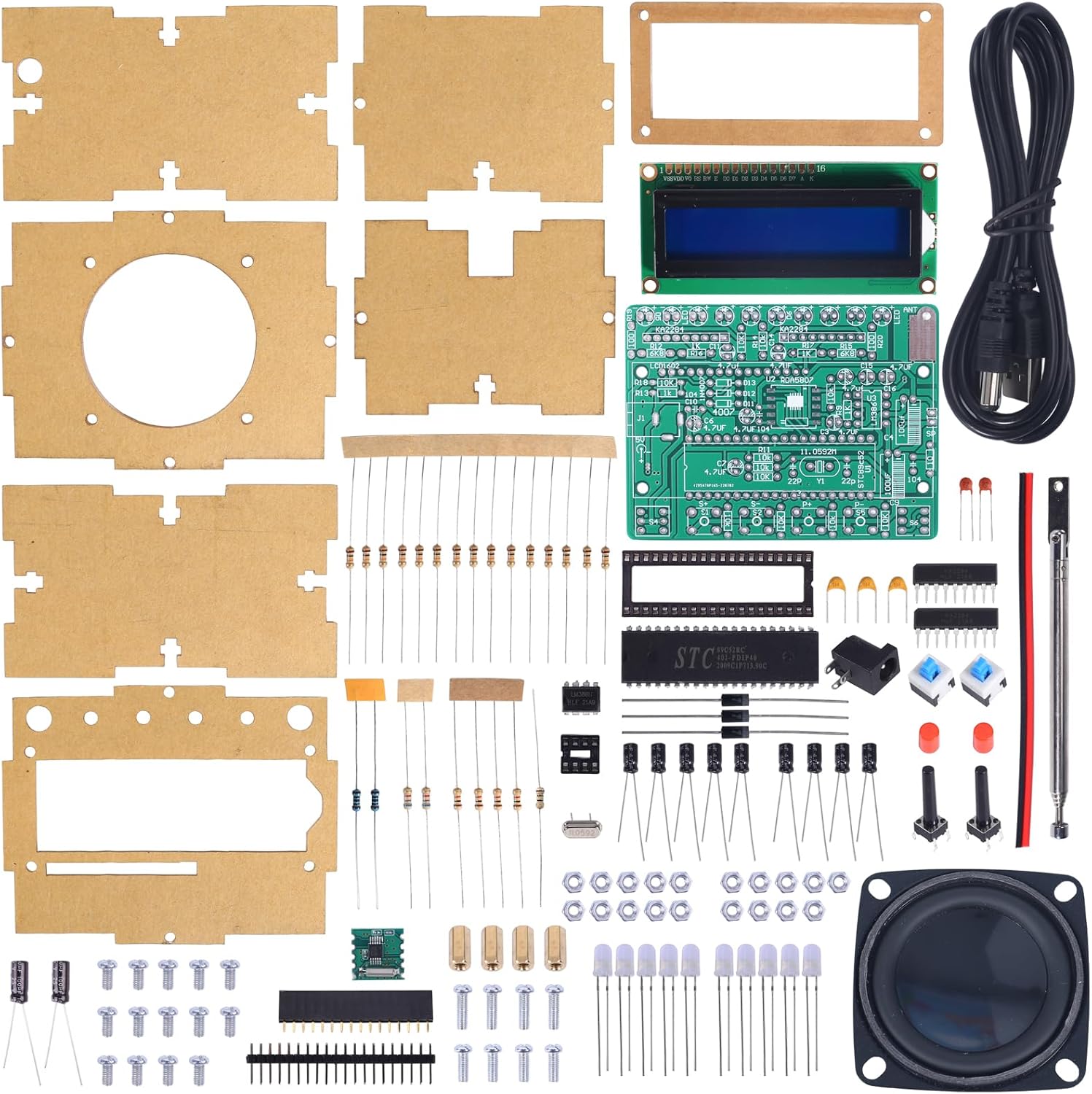
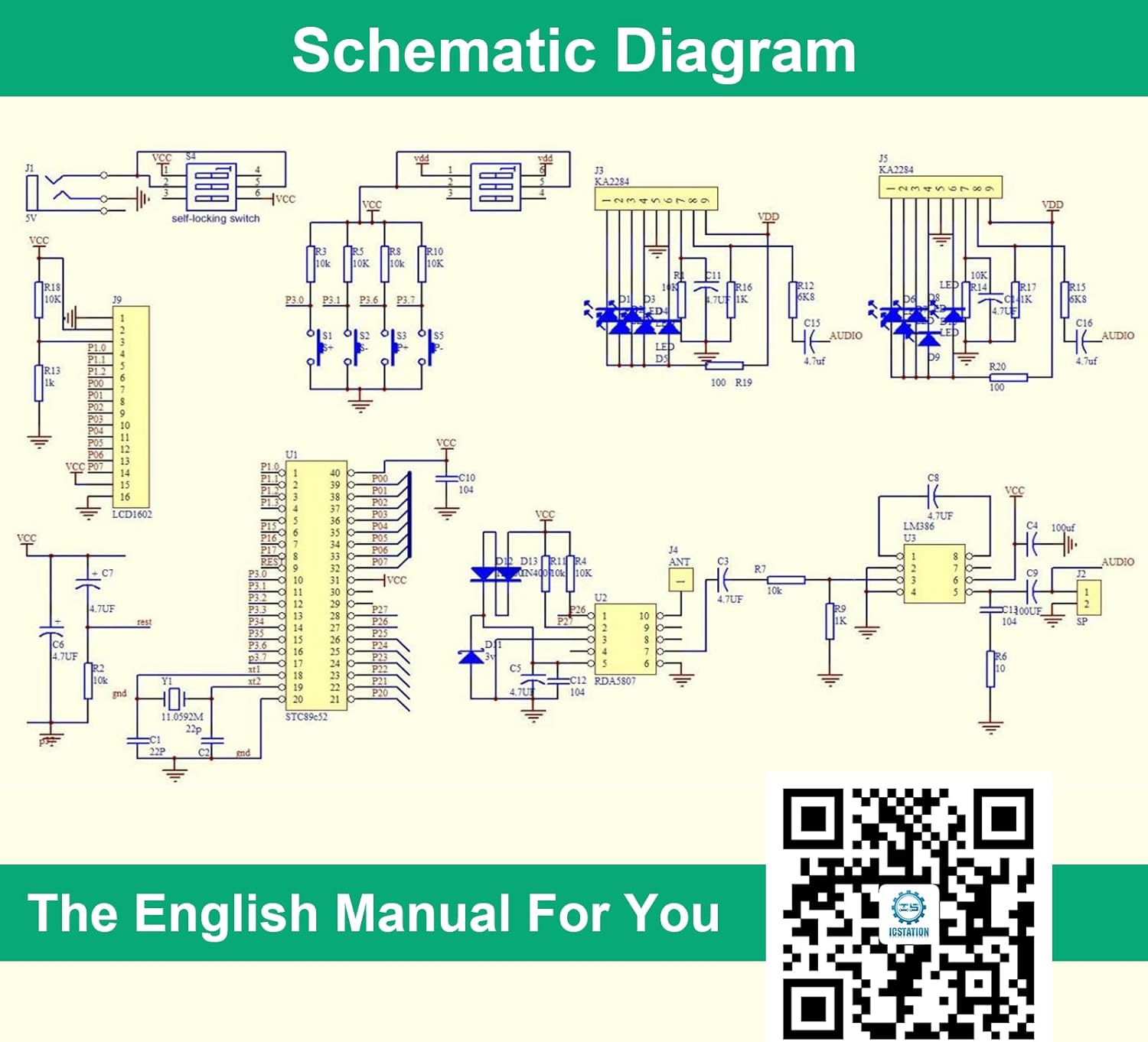
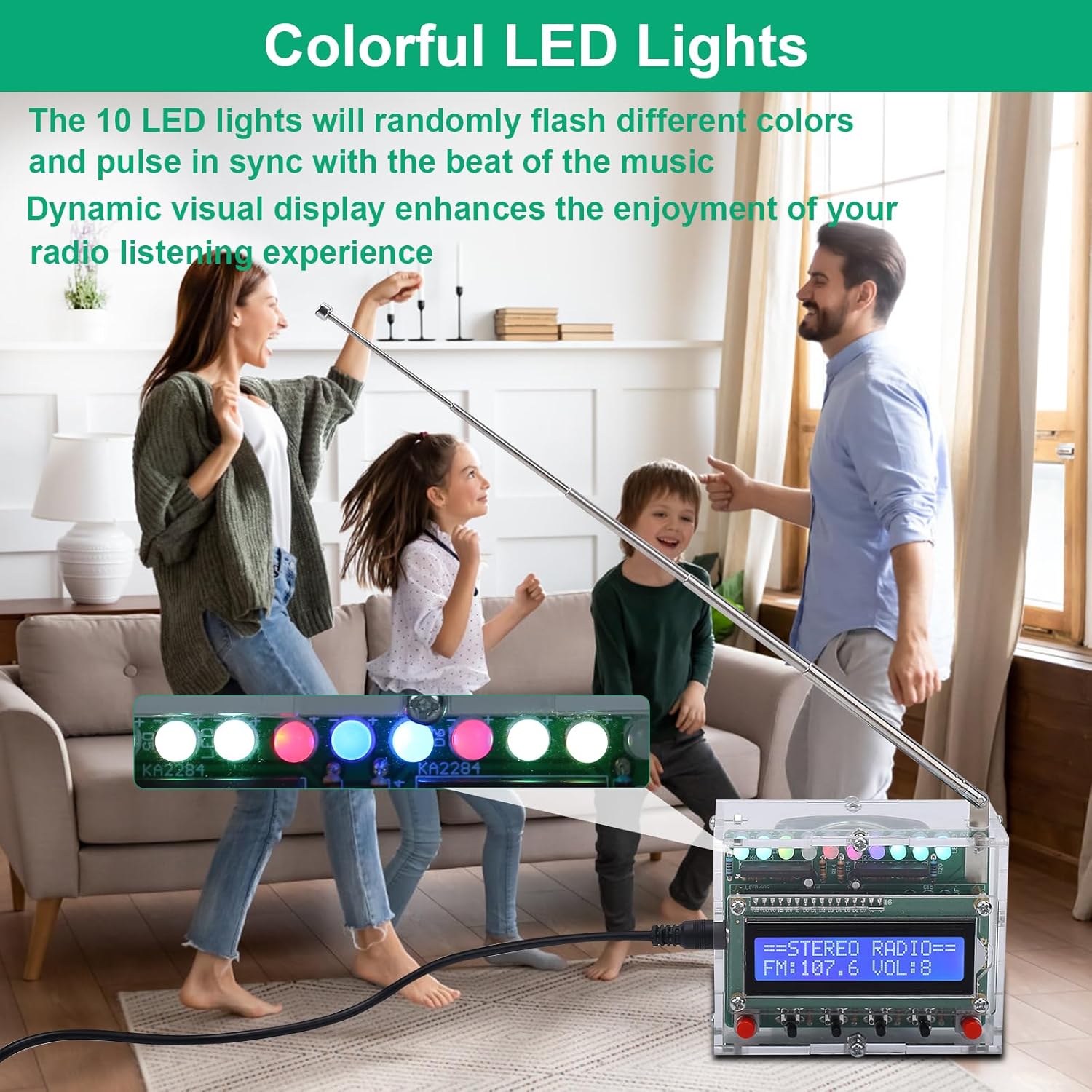
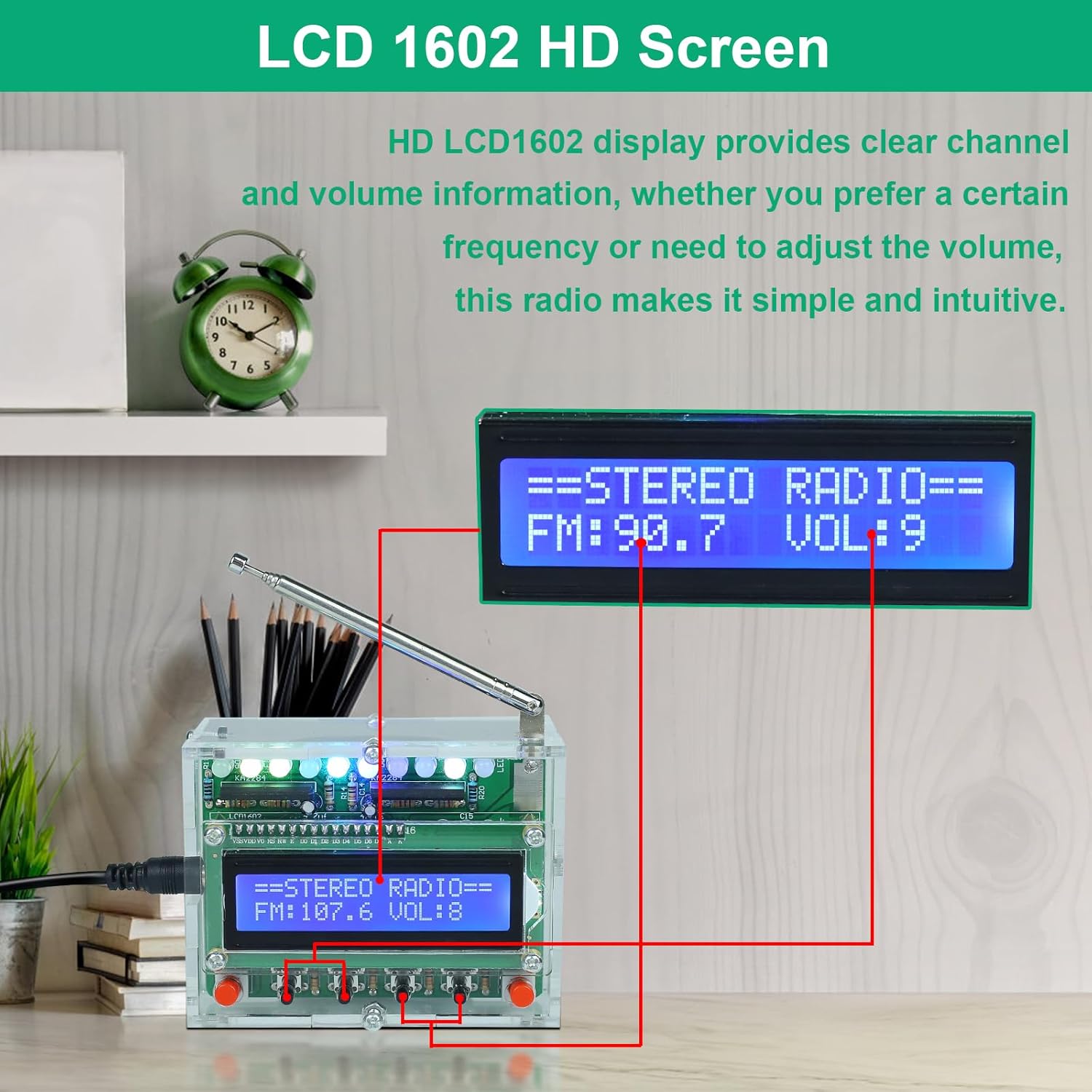
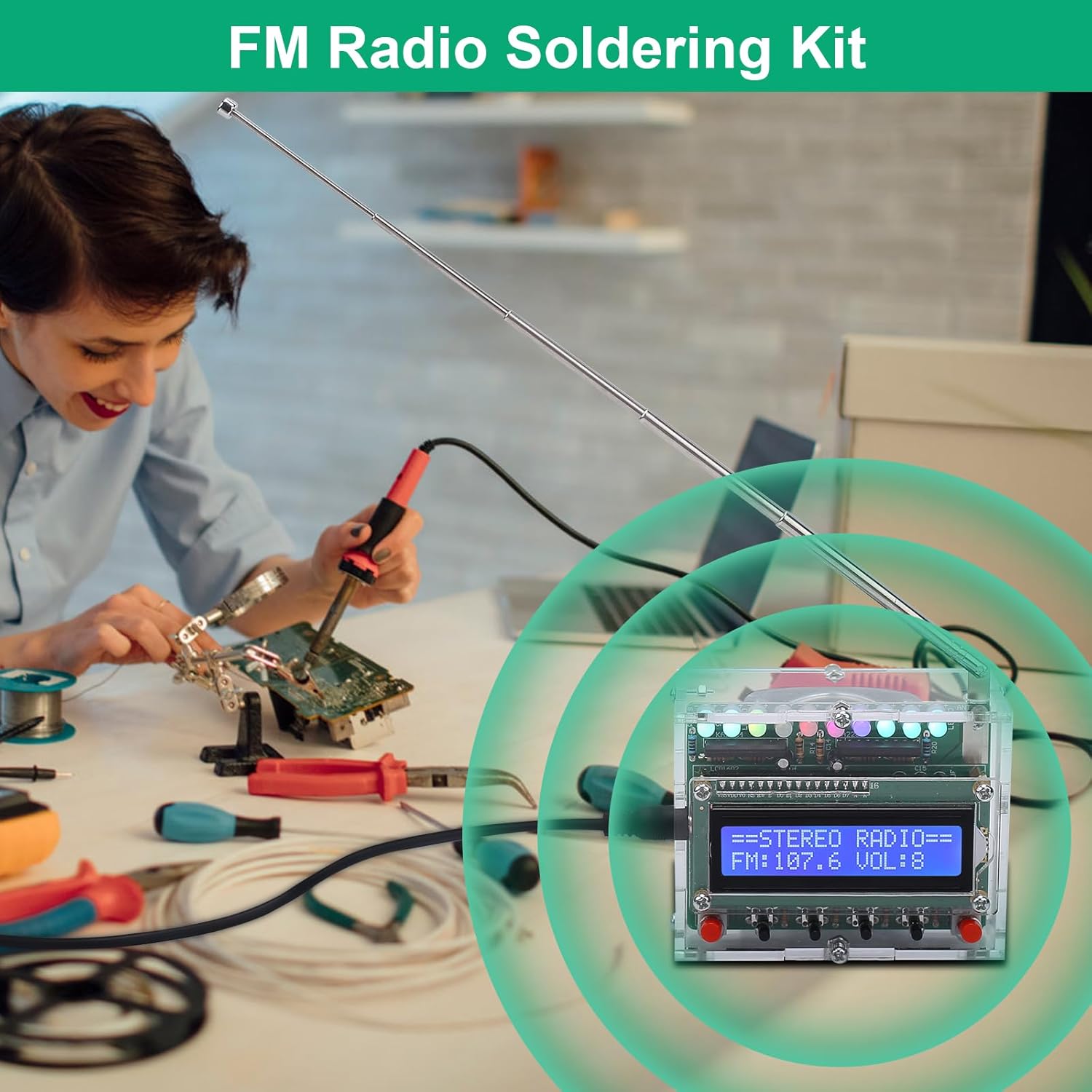
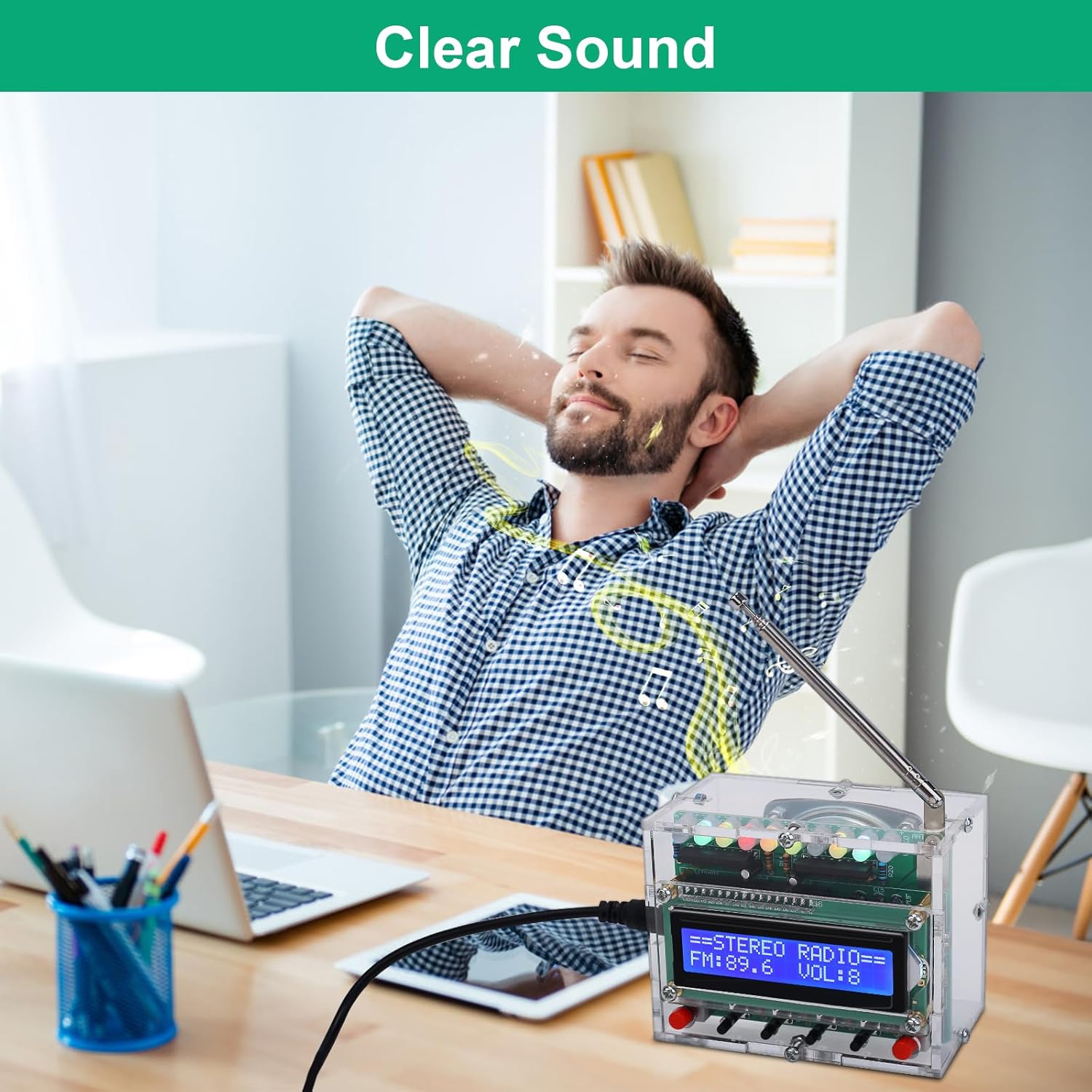
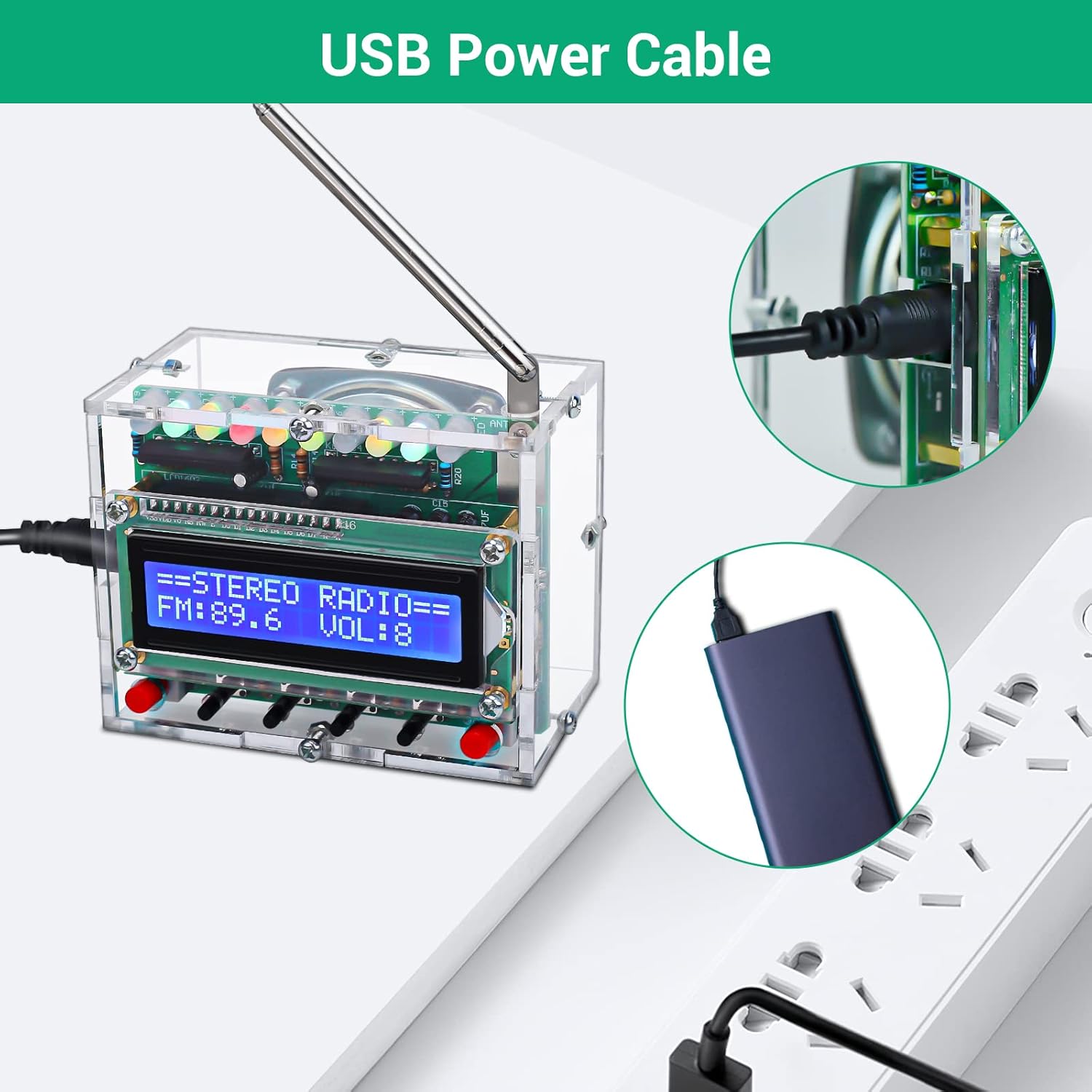



mkingDecember 5, 2024
Very fun project!
This project is extremely fun! The instructions were clear and the PCB was great quality to practice my soldering skills. Nothing was too challenging, but it was complex enough to make for an entertaining project. The radio sounds great for it’s size, and the lights are a nice touch. They can also be turned off if desired. Great value for the money! All parts were provided and everything fit together perfectly!
Awesome but with a questionable detailDecember 5, 2024
Awesome but with a questionable detail
Apparently the instructions asks you to solder the antenna onto the board…. WHY!? Questioned it at first but did it anyways and it took me a solid hour and a crap ton of tin to get it to hold in place. Make it easier for yourself and find a screw and nut that fits into the holes and you’re all set.
RC Helicopter FlierDecember 5, 2024
Great Radio Kit and Project to Teach Basic Electrical Engineering Skills and Soldeirng
I got this radio kit to teach my 12-year-old sister how to solder and assemble as a way to teach basic electrical engineering principles and terms. Upon unboxing the kit, I found the acrylic box was separated in its own space while the electrical components were in their own ziplock bag which is great and prevents scratching of the acrylic and losing electrical components. However, the instructions werenât included, but I looked at the listing and found the instructions there as a PDF file. The PDF instructions were very high quality, and the English was pretty good for a kit like this and very understandable. There was also a list of materials which tell the item names and their quantities as well as a circuit schematic. The instructions even used proper engineering terms. As I was at a house without access to a soldering station, all that was available was a $3 harbor freight soldering iron and some very cheap solder. First, I explained the components and gave a brief overview of how each one works. I then taught my sister how to solder and soldered two pins of the SMD component to show her was it was like and explain. I then let her solder the rest of the pins, and amazingly, she was able to solder them correctly. She was also able to solder all the resistors, and the header pins, and the LEDs without more than 2 bridged connections which she corrected on her own without me telling her how to correct them. As this was her absolutely first time soldering and she did so well and picked it up without a problem, I was very amazed. As an electrical engineering student myself, I see a good number of college students (around half) having trouble soldering their boards of even easier difficulty and a lot of them even messing up their boards and needing to get a new one. After doing about half of the kit, my sister wanted to take a break, so I let my 16-year-old brother complete the rest of the kit which he easily did as he has been soldering for a while.I also let my brother assemble the acrylic part. As acrylic smudges with fingerprints, he made sure to not touch the inside surfaces of the acrylic as he installed the panels to prevent the final product from looking dirty. Once the product was assembled, we applied power via USB port and the product turned on. Upon changing the channels and cycling all the way through, we couldnât get the radio to pick up any radio stations. However, the radio was tested in Japan and the FM band in Japan is about 76-90 MHz while in America, the FM band is about 88-108 MHz. Furthermore, the frequencies in Japan are in different increments for tuning than in the US. This radio supports frequencies 87-108 MHz and most radio stations in Japan also aren’t going to be close to 90 MHz either. This explains why the radio doesn’t pick up Japanese radio stations. While the radio doesn’t pick up Japanese radio stations at all, this is not a design flaw of the radio at all and it was demonstrated that the radio does work on US frequencies when I used a radio transmitter to test. . We tested the radio by using a portable radio transmitter and set both the transmitter and this radio kit to the same channel and it picked up the sound perfectly. The sound quality was really decent for a radio. That tells that the radio kit does work.Regarding the functions of the kit, there were minor things I found awkward. The volume increase button and decrease button were âswitchedâ in a way. Volume up was on the left and volume down was on the right. The same was done for the channel increase and channel decrease buttons. This âswitchingâ wasnât intuitive and goes against what you would expect and can cause confusion. The other thing was the screen said stereo on it, but this radio isnât stereo at all as it is only one speaker and therefore mono. This isnât a bad thing, but the screen shouldnât mention stereo.Overall, I am pretty satisfied with this kit. For one, it has taught my 12-year-old sister to solder and allowed her to find that she could solder to a very reasonable proficiency at such a young age and at her first try which I am sure she found amazing. Now, she discovered another skill she could use later which is very useful. My brother liked soldering it up too and assembling the product and I enjoyed using it as a teaching tool and we all enjoyed testing the final product. The whole assembly process in itself was a lot of fun. While we did it in one sitting, I would highly recommend doing half the assembly, taking a break, then doing the other half. The things I would recommend improving are having the volume buttons and frequency buttons arranged so left is lower volume and up is higher volume. I would recommend also having the volume settings persist even when power is removed. I would also recommend including a headphone jack to listen with headphones and get stereo sound as well as having an audio in jack to allow the radio to also be used as a portable boombox. Otherwise, the product is really cool and functioned as intended. The LEDs were an extra cool feature that is fun to watch as the radio plays too. Overall, I am giving this product a 4.5-star review because the volume and frequency buttons were âreversedâ and there isn’t any stereo output as it says as well as there not being AM channels or an audio in. Since Amazon doesn’t allow 4.5-star ratings, I am rounding to the nearest whole number which is 5. Overall, I am very satisfied with this product and the teaching/learning opportunity it brought.
James ADecember 5, 2024
Had a bunch of fun putting this together, but could not get it to work
Putting this device together was brilliant fun. It is like jigsaw, for adults, but after your done, the jigsaw does something. Brilliant! The fundamentals are unimpeachable.One thing that was slightly disappointing was that it did not actually work. The display did not show the frequency or the volume, and no sound played out of the speaker. I am open to the idea that I’m doing something wrong, but it’s kinda hard to find out what. No debugging instructions are provided, so if you screw something up, the first indication you’re going to get is when nothing happens after you press the button on the assembled device.I have some friends who are really into this sort of thing, and I’m pretty technical myself. So I went on a bit of an odyssey trying to figure out what was wrong. The first thing I tried was probing a bunch of the connections on the board and comparing resistances and continuities to the schematic in the instruction. That’s when I noticed that I have three more diodes on my board than are shown on the schematic. Whaaat? It turns out these diodes are on the receiver power circuit, presumably to decrease the noise coming from the power supply. They are on the newer revision of the instructions, which can be found on the Amazon page, but not the revision present in the box you receive.I couldn’t find any issues with my multimeter. I found datasheets for all the components. I learned that the microcontroller (the big chip with STC labelled on it) communicates with the receiver via I2C. My friend suggested that I snoop on/inject I2C commands to the receiver to see if it was actually responding. I soldered some dupont headers onto the receiver and hooked it up to my Raspberry Pi. I was able to run i2cdetect and I found that the radio was indeed responding to I2C. What’s more, that caused it to turn on! Cool! All I heard was static though . . .So I wrote a userspace I2C controller program for this receiver board to try to get it to work. This also did not succeed. I was able to set some of the values (like mute, the volume, etc.), but I could not get the receiver to tell me anything about its current frequency, and none of the frequency adjustment nor seek functions seemed to work.Update: I was able to adjust my code to get *everything* working. But, the device still could not pick up any stations in the middle of a large city. So, for what it’s worth.At this point, I think I’ve hit a wall with this device. I’m sad I couldn’t get it working, but it still provided hours of good entertainment, so it’s hard to complain.
kmaDecember 5, 2024
Assembled and does not work, no schematics or manual provided.
I have assembled many electronic kits in my 65 years and this one looked nice for a fun project. The circuit board was printed nicely with all the component and values needed for assembly. A manual would have been nice of some sort if you had any questions. I assembled this kit, went over all my solder connections to make sure there were no solder shorts and properly installed components. I powered up the radio and only get blocks on the top line of the display and back light on the display. I couldn’t see a contact for this vendor to ask questions or get a schematic to try to troubleshoot the kit. The antenna will not screw mount to the board unless you solder a cable to the board and mount the antenna on something else. Whole is to small on the board where the antenna mounts. Fun kit if it would work when completed.
Ian G DalgleishDecember 5, 2024
The radio works well. There are clear instructions on the web. The case is a nightmare to assemble. I used blu-tak to hold the nuts in place while putting the screws in.
ä»äº æ December 5, 2024
ååå°çããããä¸å½ããéå°ããé¨åæããå説ãªãããã§ã©ããã£ã¦åå¿è ã¯ä½ã£ãããããã ã»ã»ã»ã»ã»åå説æã®æ¬ã«ä½ãæ¸ãã¦ãªããããããä½ããªããçãã
Amazon CustomerDecember 5, 2024
Components and PCB looked to be good quality, but why such a project would not come with instructions is a bit unusual. My son and I spend hours following every step to the letter once we did eventually find instructions, but it wont work. We get a buzzing sound in the speaker, and the frequency buttons will not work. AND, the PCB had 3 extra areas not listed in the instructions, and we didnt have all the capacitors to complete it as the PCB outlinesâ¦. Very disappointed 10 year old here, for his first solder kit project.